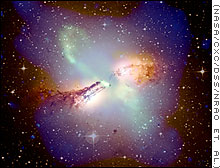CNN: Chandra spies bursting galactic beauty (Photo)

Centaurus A is about 11 million light-years away.
á
(CNN) -- Besides offering some exceptional eye candy, the enormous explosion of a nearby galaxy provides a glimpse into the workings of massive black holes and intergalactic relationships.
The galaxy, known as Centaurus A, is a color-packed assortment of arcs, jets and dust streaks, the result of a big burst millions of years ago.
The celestial object only came into its psychedelic glory when astronomers pieced together images in different energy wavelengths from numerous space and ground telescopes.
The composite draws on the collective vision of NASA's orbiting Chandra X-ray Observatory, the Hubble Space Telescope and the Very Large Array in New Mexico, depicting radio emissions in red and green, optical emissions in yellow and orange and X-ray in blue.
"Suddenly it all clicked in, as with a giant puzzle, and the images fit together to make a complete picture of the galaxy geometry that was not apparent before," said Margarita Karovska, lead author of a paper on Centaurus A in the September 6 issue of The Astrophysical Journal.
In the portrait of the turbulent galaxy, two enormous arcs of gas at temperatures exceeding millions of degrees are part of a dust ring that extends 25,000 light-years in diameter.
Perpendicular to the arcs, two jets shoot out high-energy particles, powered by an unseen super massive black hole in the galactic center, according to Chandra astronomers.
Based on the twisted structure of the galaxy, including the speed and distance of outgoing shock waves, some members of the scientific team estimate it experienced a major explosion in its center about 10 million years ago.
Other researchers speculated that the cosmic tea leaves show Centaurus A ingested a smaller galaxy about 100 million years ago.
Galactic mergers, unleashing enormous amounts of energy, can spark an intense spurt of star production, increase the size of a central black hole and kick out into interstellar space the gaseous building blocks for later generations of stars.
The conditions could resemble those when the universe was much younger. And active galaxies like Centaurus A could have played a critical role in the evolution of galaxies in the early universe, when galaxies crashed into one another with much greater frequency, according to astronomers.
"Centaurus A, at a distance of only 11 million light-years, gives us a rare opportunity to study such an active galaxy in action," said Giuseppina Fabbiano, co-author of the paper.
http://www.cnn.com/2002/TECH/space/08/13/chandra.centaurus/index.html